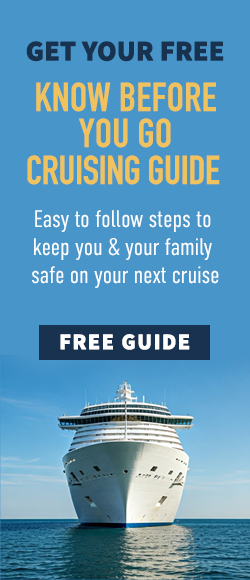A 2019 advertisement for tours of New Zealand’s White Island promised Royal Caribbean cruise passengers an up-close experience with one of the country’s most active volcanoes. Appearing in the company’s cruise marketing packages, the ad described a guided hike near “bubbling pits of mud, hot volcanic steams and the amazing lake of steaming acid.”
From the ship’s port of call, tourists would be transported to the seaside town of Whakatane and then ferried 30 miles to the uninhabited island, which forms the top of a submarine volcano extending deep under New Zealand’s Bay of Plenty. Gas masks would be handed out to protect tour groups from the volcano’s acrid air while they explored a jagged landscape mottled with bright yellow sulfur deposits.
Royal Caribbean and its tour contractors sold excursions to White Island for years until tragedy struck on December 9, 2019. At 2:11 p.m. local time that day, the volcano violently erupted, spewing ash and hot gas onto tourists, including 38 vacationers from Royal Caribbean’s Ovation of the Seas.
Twenty-two people suffered fatal injuries. Survivors sustained burns so severe that dozens of square meters of transplantable skin had to be flown in for grafting surgeries, according to court documents. The disaster generated international headlines and called into question the safety of active-volcano tourism in New Zealand and around the globe.
Victims and family members of those killed are now pursuing a string of lawsuits to hold Royal Caribbean liable in its home base of Miami, where the company operates a flagship cruise terminal and corporate offices.
Among the plaintiffs is Australian Stephanie Browitt, who suffered extensive burns and still wears pressure wraps around her face and arms. She has become an advocate for burn victims, publicly chronicling her recovery and two-year journey through countless surgeries.
Browitt’s family had saved up for a Royal Caribbean vacation in 2019 and were celebrating her younger sister’s 21st birthday at the time of the tragedy. The siblings and their dad were near the crater when the volcano erupted. (Browitt’s mother remained on the ship, forgoing the tour owing to medical issues.)
“Covered with burns and barely able to move, Stephanie [Browitt] staggered toward the jetty, with other passengers screaming and grabbing at her legs as she went. She made it to the jetty, where she waited on the hot ground for rescue. Every 15 to 20 minutes, she could hear her father calling her name and she realized he was trying to help her stay awake,” her attorneys stated in Miami-Dade County Circuit Court.
Stephanie Browitt fell into a coma and awoke in the hospital two weeks later. Her sister, Krystal, and father, Paul, did not survive their injuries.
The Browitt family has retained Coral Gables lawyer Rebecca Vinocur to handle their case.
“Tourist excursions to this powder keg could not be made safe under any circumstances, but Royal Caribbean compounded its error by ignoring evidence of heightened risk and failing to tell the passengers to whom it sold tickets anything about White Island’s eruption history,” Vinocur argues in the lawsuit.
Vinocur is also representing a Vero Beach couple suing over the death of their daughter, Barbara Noesen Hollander. Barbara, her husband Martin Hollander, and their two teenage sons all died of injuries suffered during the eruption. One of the boys, 13, is believed to have been the youngest of the 22 people killed in the eruption.
Michael Winkleman, a Miami attorney at Lipcon Margulies who’s representing several other plaintiffs, tells New Times that his clients were sent directly into “the mouth of the volcano.”
He says tour groups were taken to the edge of the crater despite signs that the volcano was in its highest state of unrest since 2016, when it had last erupted.
“There was a huge volume of scientific readings and volcanologists saying that there was going to be increased volcanic activity. That should have led to a cancellation of the entire tour,” Winkleman says.
Three weeks prior to the eruption, New Zealand’s seismic monitoring agency GNS Science raised White Island’s volcano activity rating to Level 2, which reflected a significant shift in volcanic unrest. Days later, on November 24, 2019, a strong earthquake was recorded with an epicenter a few miles from the island. GNS noted on a December 3 bulletin that the volcano was spewing debris 60 feet into the air and that “volcanic gas emission and seismic activity continue to remain elevated.”
The plaintiffs claim that neither Royal Caribbean nor its tour contractor, White Island Tours, explained to them before the excursion that the volcano’s increased activity put them at risk of being caught in the middle of a catastrophic eruption.
Winkleman argues that since Royal Caribbean set up, advertised, and sold the tour, the company had an obligation to closely monitor volcanic activity. He described these kinds of off-ship excursions as a “huge moneymaker” for Royal Caribbean, as it often splits the revenue with tour contractors. The cruise ship company’s materials referenced in court documents indicate that the White Island tour was priced around $250 at the time of the eruption.
Experts had been warning for years about the dangers of taking tourists on treks around the island, according to the Miami lawsuits. The New Zealand Ministry of Civil Defence had allegedly stated as early as 1996 that explosive activity around the crater threatened the safety of the ever-growing influx of visitors.
In a 2013 article by travel writer David Molyneaux, one volcanologist is quoted as saying he was troubled by tourist activity on White Island. “It’s not an amusement park attraction. It’s a gaping hole in the surface of the earth that could explode catastrophically and unexpectedly,” the scientist, Erik Klemetti, told The Travel Maven blog.
The lawsuits also point to an April 2019 study that looked at past violent explosions on White Island, focusing largely on the 2016 eruption. (The volcano had a series of eruptions between 2012 and 2013, as well.) The study authors, including GNS Science volcanologist Geoff Kilgour, wrote that White Island eruptions “clearly pose a significant hazard to the tourists.”
“To compound poor forecasting, these areas are frequently popular with tourists and eruption hazard footprints may be poorly constrained, creating an elevated risk to life and safety,” the study found.
Royal Caribbean has not yet filed responses to the newest lawsuits over the White Island disaster. But in the Browitt family’s case, the company argues that cruise passengers knew or should have known that visiting an active volcano came with risks.
“Advertising an ‘active volcano’ should be sufficient terminology to indicate that the tour bears individual recognition of danger,” Royal Caribbean stated in a motion to dismiss Browitt’s case in Miami-Dade circuit court.
The cruise company cites past negligence cases where courts have declined to fault defendants for not warning of dangerous conditions if they were “open and obvious.” (In one cited Florida case, a woman sued cruise giant Carnival after she was bitten by a snake on a Belizean rainforest tour offered as an off-ship excursion. The court ruled in favor of Carnival, finding that the risk of encountering a dangerous animal in the rainforest was self-evident and that the company, therefore, had no duty to warn her about it.)
Royal Caribbean’s defense in that vein has so far failed in lawsuits filed by victims of the White Island eruption. A federal judge last month rejected the company’s argument to dismiss the Singh family’s claims on account of the “open and obvious” risks of volcano hiking. The judge ruled that although the general risk of an eruption is obvious, it may have been unclear to tourists just how dangerous White Island could be in light of recent volcanic activity. (The judge allowed the Singh lawsuit to proceed, though he granted dismissal of some of the counts, including a count against Royal Caribbean for negligent retention of White Island Tours.)
In each of the pending Florida cases, Royal Caribbean’s attorneys have downplayed the Level 2 volcanic-activity rating assigned to White Island at the time of the eruption. They’ve focused on a section of New Zealand’s December 3, 2019, White Island bulletin that states that “the current level of activity does not pose a direct hazard to visitors.”
Plaintiffs have responded by pointing out that the next highest rating — Level 3 — indicates an active eruption. That is to say, Level 2 is the highest rating available in New Zealand before a live eruption is taking place.
Royal Caribbean has not responded to a request for comment from New Times.
“Notoriously Difficult to Predict”
The type of explosive activity common on White Island in recent years is known as a phreatic eruption. Such eruptions occur when underground water in volcanic systems heats up rapidly into steam, causing it to expand with explosive force.
Stephen McNutt, a Florida-based volcanologist and researcher, explains that traditional volcano forecasting methods typically don’t work for phreatic eruptions.
“Most of the strategies that work for eruptions are based on tracking magma movements. Phreatic eruptions are trickier. I know several cases like White Island where they’ve happened with very little warning. They are notoriously difficult to predict,” McNutt, who is not involved in the litigation, tells New Times.
One such disaster took place on Mount Ontake in Japan in September 2014, when a phreatic eruption killed more than 60 people.
McNutt notes that volcanic-activity rating systems are not always meant to pinpoint when an eruption will occur. The lack of certainty around the timing of phreatic eruptions, in particular, can prompt volcano tour operators to discount forecasts, he says.
“It’s forecast broadly in terms of risk. With White Island, I think the scientists were concerned that something was going to happen,” McNutt explains. “But when you say something’s going to happen, then immediately someone is going to ask ‘When?’ Then if you reply, ‘I don’t know,’ [and] there’s economic activity involved, a guy whose livelihood depends on tourism is going to claim, ‘Well, you don’t have any specific information.'”
New Zealand’s volcano-activity system is a five-tier scale, with Level 2 described as “moderate to heightened volcanic unrest” with “potential for eruption hazards.” Level 3 indicates an active “minor volcanic eruption.”
By comparison, Japan’s volcanic activity ratings — which are likewise based on a five-tier scale — more directly state evacuation plans and safety instructions. For instance, Japan’s Level 2 volcanic rating instructs hikers around volcanoes to “refrain from approaching the crater,” while a Level 3 rating directs disabled residents nearby to prepare for potential evacuation.
McNutt says that as the volcano tourism industry continues to boom, simple steps such as a brief training session could help tourists prepare for and understand the risks of a hike around an active volcano. In public statements, the Singhs’ surviving nephew urged volcano tour operators around the globe to provide tourists with better safety equipment and heat-resistant clothing, which he says could have saved his aunt and uncle.
Concrete shelters are another potential safety measure, one that has long been implemented at some volcanoes popular with tourists, such as Mount Aso in Japan.
Royal Caribbean is currently vying to route Stephanie Browitt’s lawsuit into Australian court. The company says that when they booked their cruises aboard the Ovation of the Seas, Browitt and other Australian claimants agreed that legal disputes would be brought in the eastern Australia state of New South Wales.
An Australian court this past June ruled that those contract terms applied only to Royal Caribbean’s subsidiary, RCL Cruises Ltd. But the cruise giant claims the decision “has no legal force or effect” in Florida.
Browitt’s attorney, Rebecca Vinocur, argues in a recent filing that Royal Caribbean has been inconsistent on its position about Australian jurisdiction.
The lawyer maintains that Miami is the proper venue for the case as it’s Royal Caribbean’s “backyard” and corporate headquarters. The Australian judge wrote in June that “the damages likely to be recovered in the Florida proceeding are significantly higher than could be expected to be awarded by an Australian court.”








